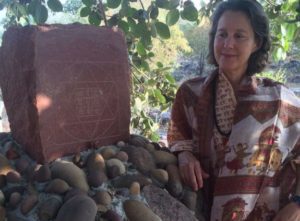The Vedas tell us that the Soul is born with four desires – Dharma (purpose), Artha (the means to fulfill our purpose), Kama (the desire for pleasure and enjoyment) and Moksha (liberation). It was desire, in fact, that initiated the creation of the universe itself. In his book, The Four Desires: Creating a Life of Purpose, Happiness, Prosperity and Freedom, Yogarupa Rod Stryker writes that desire is the source of everything. The Yajur Veda, he writes, “tells us that divine desire, or kama, created the world. Without this desire, the world would not exist.”
Tantra, defined as that which allows us to expand beyond our limitations, sees the world and everything in it as a manifestation of divinity, and therefore the material, when skillfully utilized, can be a means to spiritual fulfillment and liberation. And because desire is here to stay, we need to discern our Soul’s true desires from instinctual drives in order to be fulfilled and live in alignment with our greatest purpose and fulfillment. Otherwise, we are pulled by our drive for sensory pleasures, often in destructive or non-constructive ways.
Through meditation and self-inquiry, you can learn to identify a sankalpa, a resolve or intention, that can move you closer to your overall purpose, or dharma. At any point in your life, one of the four desires will feature more prominently as a focus of resolve. For example, you may wish to have more freedom to enjoy your life (kama), but first you must regain your health after a chronic illness (artha). Lifestyle changes that will give you the stamina to engage in pleasurable activities would be the first step to achieving the desire of kama. Or you may need financial stability, and a secure home, which are also expressions of artha.
In my video, Creating the Perfect Intention, you can engage in the process of identifying a desire from which your intention will emerge. Using stream of consciousness, you will identify the words that will give shape to your sankalpa, a desire or intention you wish to manifest within 6-18 months. This intention should be measurable and include steps that you will take to achieve it. It should also be written as if it has already been accomplished. As an example, I had a fear of videotaping a class for my yoga certification, so my intention to read: “My video is done, and I am a ParaYoga certified teacher!”
But change is difficult, and resistance is to be expected. Even when we dare to dream of what we most desire to manifest, the force of our habits and patterns will conspire to hold us back. In today’s world, social media addiction is a perfect example. When we have a free moment, we often click on our devices rather than interact with others or engage in a productive activity to move us towards greater achievement. In my second video, Overcoming the Obstacles to Manifestation, you will learn about the “Creation Equation” and learn to maximize the power behind your intentions, so they can materialize, by agreeing to release an unhealthy habit.
Finally, I offer you a tantric meditation to increase empowerment. Through this meditation practice, you can connect to the creative forces of will, power, and determination residing in your manipura or third chakra. Using breathing techniques, visualization, concentration, and mantra, you can create fertile internal conditions to give power to the seed of your intention.
If you enjoy this process, and would like to engage in a formal Four Desires process, you can search for a certified Four Desires mentor/facilitator at https://www.parayoga.com/certified-teachers/
By Inge Sengelmann
Inge Sengelmann is a somatic psychotherapist and certified ParaYoga teacher, initiated in the Himalayan Tantric lineage of Sri Vidya. ParaYoga is a living link to the ancient traditions of yoga, meditation, and tantra.











